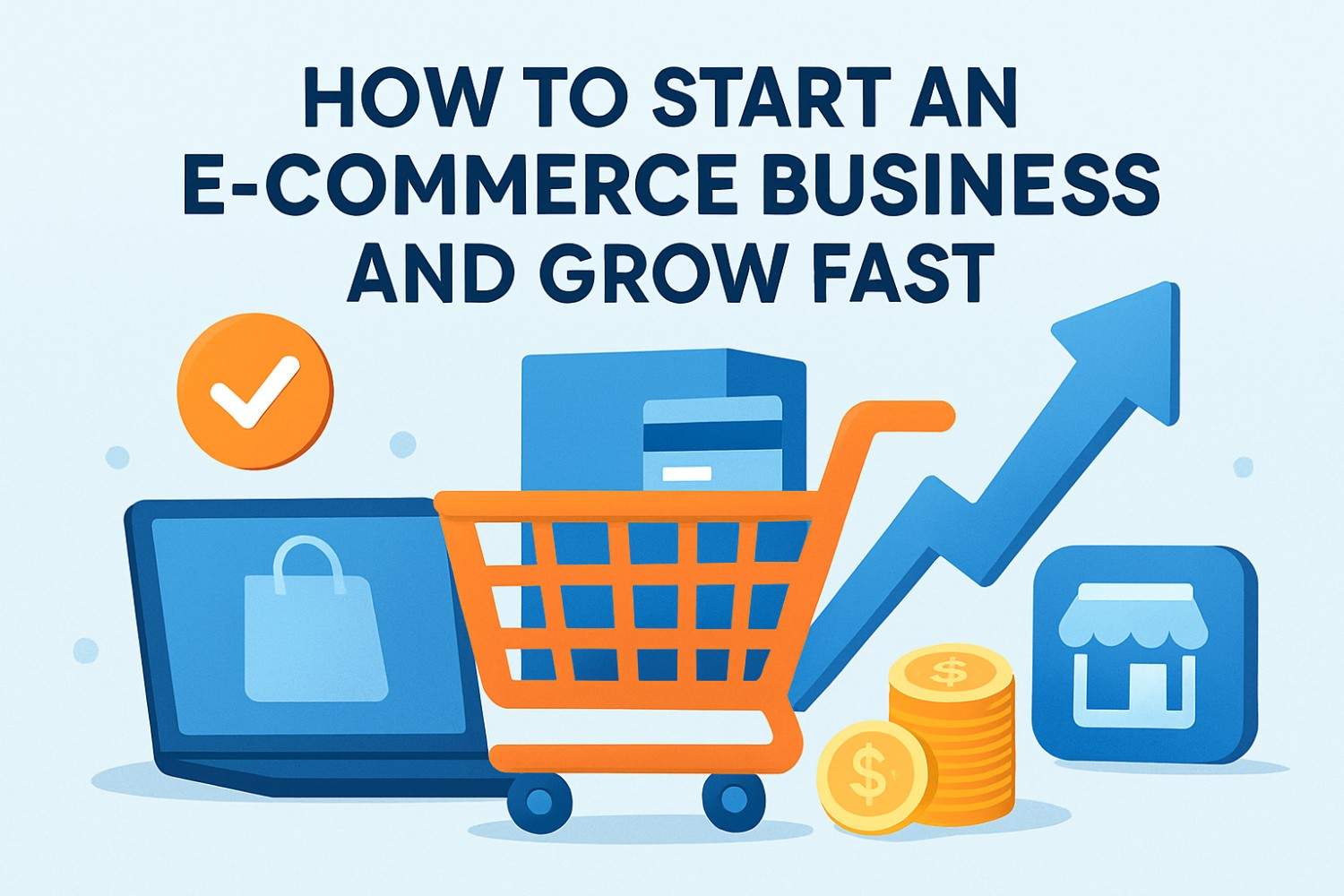
Introduction
Starting an e-commerce business is one of the best ways to turn your ideas into profit. With more people shopping online than ever, it’s the perfect time to bring your products or services to a global audience. Whether you’re selling handmade items or launching a brand, e-commerce gives you the power to grow from anywhere. All you need is the right approach, creativity and consistency to build a business that stands out online.
10 Proven Tips to Start Your E-Commerce Business
1. Choose the Right Product or Niche
The first step in starting a successful e-commerce business is picking the right product or niche. Your product should solve a problem, meet a need, or appeal to a specific group of people. Use tools like Google Trends, Amazon Best Sellers, or social media to find popular products. Consider factors like cost, shipping, and competition. You can start small with dropshipping or a limited inventory to test the market before investing heavily. Choosing a focused niche helps you attract the right customers and stand out in a crowded market.
2. Understand Your Target Audience
Knowing your customers is key to success. Learn about their age, interests, location, and shopping habits. Create buyer profiles to represent different types of customers and understand what challenges they face. This helps you design products, website content, and marketing messages that appeal directly to them. For example, if you sell fitness equipment, your audience might be young professionals who follow health and wellness trends. Knowing your audience makes your communication clear and increases the chances of making sales.
3. Conduct Competitor Analysis
Looking at your competitors helps you understand the market and find ways to stand out. Check what products they sell, their prices, website design and marketing methods. Read customer reviews to see what people like or dislike about their products. Use tools like SEMrush or SimilarWeb to see their website traffic and keywords. Understanding competitors helps you create a unique selling point, whether it’s faster shipping, better service, or superior product quality.
4. Create a Strong Brand Identity
A strong brand helps people remember your store and trust your business. Your brand is more than a logo – it represents your values, personality and mission. Use consistent colors, fonts and messaging across your website, social media and packaging. Share your story to connect emotionally with your customers. A clear and professional brand identity makes your business look reliable and encourages customer loyalty.
5. Build a Professional Website
Your website is your online store and it should make a great first impression. Make sure it is mobile-friendly, fast and easy to navigate. Use high-quality images and videos to showcase your products and write clear descriptions highlighting their benefits. Make the checkout process simple and secure. Include trust signals like SSL certificates, secure payment badges and customer reviews. Platforms like Shopify, WooCommerce, or Wix make it easy to create a professional website without coding knowledge. You can also use Frequency to build a professional website effortlessly.
6. Set Up Secure Payments & Shipping
Secure payments and reliable delivery are essential. Offer multiple payment options like cards, PayPal, UPI, or wallets and make sure transactions are encrypted. Work with trusted shipping companies for fast delivery and tracking. Offering free shipping or multiple delivery options improves customer satisfaction. A smooth payment and shipping experience builds trust, reduces abandoned carts and encourages repeat purchases.
7. Develop a Marketing Strategy
A smart marketing plan helps people find your store and buy your products. Use seo, social media, email marketing, paid ads and influencer promotions to reach your audience. Social media helps you engage directly with customers, while email keeps them coming back. Paid ads increase visibility quickly and influencer collaborations expand your reach. Track your campaigns regularly and adjust them to get better results and more sales.
8. Focus on Customer Service
Great customer service sets your business apart. Respond quickly and politely to questions, make returns and refunds easy and personalize your communication. Live chat or chatbots can improve response time. Listen to customer feedback and solve problems efficiently. Happy customers are more likely to return, leave positive reviews and recommend your store to others.
9. Monitor Analytics & Optimize
Track your data to understand what works and what doesn’t. Use tools like Google Analytics or Hotjar to monitor traffic, conversions, sales and cart abandonment. Identify your best-selling products and marketing campaigns and optimize areas that need improvement. Data-driven decisions help improve your website, increase sales and make the shopping experience better for your customers.
10. Stay Updated & Adapt
E-commerce is always changing, so you need to stay flexible. Follow industry blogs, join webinars and explore new tools and strategies. Try innovations like AI recommendations, augmented reality shopping, or subscription models to improve your customer experience. Staying updated ensures your business stays competitive, meets customer expectations and continues to grow in the evolving online marketplace.
Advanced Features to Boost Your E-Commerce Business
1. AI-Powered Recommendations
AI-powered recommendation systems analyze customer behavior, purchase history, and browsing patterns to suggest relevant products. These personalized recommendations increase the chances of additional sales and improve the overall shopping experience. For example, showing “Customers who bought this also bought…” or personalized product suggestions on the homepage encourages users to explore more items and increases average order value. Implementing AI recommendations helps businesses provide a tailored experience, making customers feel understood and valued.
2. Chatbots & Live Support
Offering instant support through chatbots and live chat significantly improves customer service. Chatbots can answer common queries, provide product information and assist in order tracking 24/7, while live support adds a personal touch for complex issues. This feature reduces response time, increases customer satisfaction and helps recover potential lost sales due to unanswered questions or confusion during the buying process. Combining automated chatbots with human support ensures seamless customer interaction and builds trust.
3.Subscription & Membership Options
Subscription and membership models create a steady revenue stream while building customer loyalty. Businesses can offer products or services on a recurring basis, such as monthly boxes, premium memberships or exclusive deals for members. This not only guarantees consistent sales but also encourages long-term customer relationships. Membership programs can include perks like discounts, early access to products or free shipping, giving customers a reason to stay connected with your brand.
4. Multi-Channel Selling
Selling across multiple platforms, such as online marketplaces, social media and your own website, helps expand your reach and increase sales opportunities. Multi-channel selling allows customers to discover your products wherever they shop, whether it’s Amazon, Instagram, Facebook, or a mobile app. Synchronizing inventory and managing orders from different channels ensures a smooth shopping experience and avoids overselling. This approach boosts brand visibility and helps businesses tap into wider audiences efficiently.
5. Mobile App Integration
As most online shopping now happens on smartphones, having a dedicated mobile app is a game-changer for your e-commerce business. A mobile app allows customers to shop faster, receive instant notifications about deals and enjoy a personalized experience. Features like one-click checkout, saved preferences and app-exclusive offers make shopping easier and more engaging. By investing in a mobile app, you can boost customer retention, encourage repeat purchases and stay ahead of the competition.
Conclusion
Starting an e-commerce business takes planning, the right strategies, and smart tools. From picking the right product and knowing your audience to building a professional website and using features like AI recommendations or chatbots, every step matters. With Frequency, you can easily create a mobile-friendly, customizable website to launch and grow your business. Combine these tips with advanced tools, stay adaptable, and you’ll create a seamless shopping experience that keeps customers coming back.







